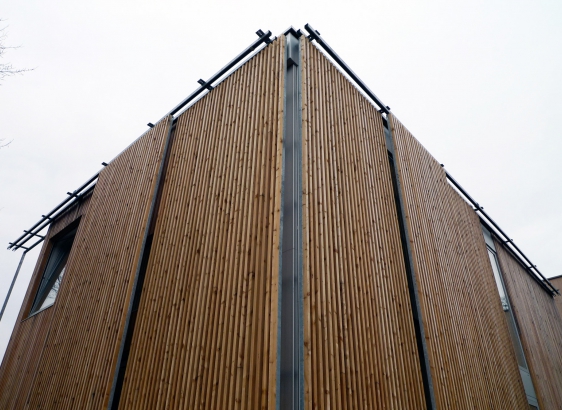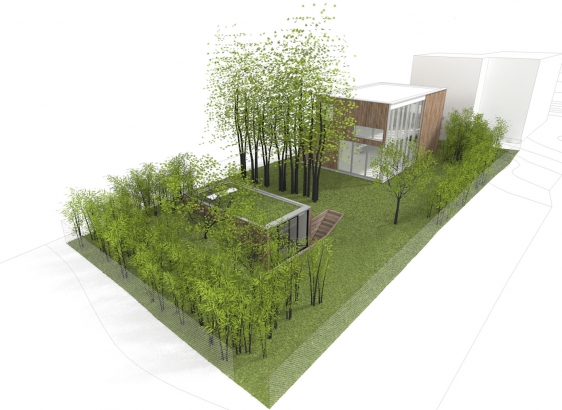Un îlot de campagne
Quand Laurence et Nathalie acquièrent le terrain, le projet est déjà amorcé: une dalle de sol est coulée et un permis en cours. A ces contraintes s’ajoute l’accès difficile du terrain situé au fond de jardins dans un quartier résidentiel.
La condition du permis est claire: le nouveau projet devra s’en tenir aux gabarits du précédent, et au matériau «bois» qui apaise les craintes d’une construction en intérieur d’îlot.
Le terrain est un petit bout de campagne où sont déjà implantées deux constructions isolées. Mot d’ordre: modestie et respect de cet environnement fragile. La commune d’Uccle se montre favorable à la construction d’une architecture aux formes contemporaines.
Le gros-œuvre comme finition
Laurence et Nathalie savent ce qu’elles veulent. Des volontés qui prennent directement un parti très graphique et des expressions directes, sans fioritures.
La maison passive, entièrement en bois, est abandonnée avec regrets; elle est incompatible avec le budget.
Le parti pris est de faire du gros-œuvre une finition en soi. Ne rien cacher et respecter le désir d’une maison où le brut s’accompagne d’une exécution sans bavures.
C'est ainsi que l’expression de la matière des poutrains claveaux structurels est adoucie par une simple peinture blanche, texturant une surface en réponse à une dalle de béton poli.
Un minutieux travail du béton
Outre le bois, le béton est un autre fantasme des maîtres d’ouvrage: la chape, l'escalier et le plan de travail de la cuisine ont été coulés sur place. L'escalier semble flotter comme un objet en suspension ; il répond à la double volonté de libérer l'espace du rez-de-chaussée et d'ouvrir la vue qui file par les baies vitrées. Central, il organise les déplacements et articule des pièces maximisées. La cuisine a dès lors pu prendre la même envergure que le salon (Laurence possède un restaurant dans le centre de Bruxelles), tandis qu’à l'étage, la salle de bain en mortex (mélange d’enduit de chaux et de résine colorée) s'est permise un volume au moins équivalent à la chambre à coucher.
Une enveloppe en bois
Comme une seconde peau, 6 coulissants en lames de mélèze brut de la hauteur de la façade (soit environ 6 mètres de haut), glissent devant les baies vitrées et prolongent le bardage en bois ajouré.
Indispensables au Sud ouest devant le mur rideau, les coulissants rythment deux façades et créent de l'intimité. La maison s'ouvre et se ferme, totalement ou en partie, selon les besoins. Quand elle s’ouvre, le jardin devient une pièce à vivre; une extension naturelle de la maison.
House Pam&Jenny
Een stukje platteland
Wanneer Laurence en Nathalie het terrein kopen, is de aanzet tot het project al gegeven: de funderingsplaat is gegoten en de bouwaanvraag is ingediend. Bovenop deze beperkingen komt de moeilijke toegang tot het terrein, gelegen aan de achterkant van de tuinen in een woonwijk. De voorwaarden van de vergunning zijn duidelijk: het nieuwe project dient zich te houden aan de afmetingen van het vorige, en aan de keuze van ‘hout’ als materiaal om de vrees voor een gebouw in een binnengebied van een bouwblok te verminderen.
Het terrein is een stukje platteland waarin reeds twee vrijstaande gebouwen werden opgetrokken. Het wachtwoord: bescheidenheid en respect voor dit breekbare milieu. De gemeente Ukkel is voorstander van een architectuur met hedendaagse vormen.
De ruwbouw als afwerking
Laurence en Nathalie weten wat ze willen. Wensen die een zeer grafisch opzet aannemen, en directe uitdrukkingen, zonder ornamenten.
Van een passief huis, volledig in hout, werd met spijt afgezien; het is niet-combineerbaar met het budget. Het gekozen uitgangspunt is om van de ruwbouw, een afwerking op zich te maken, om niets te verbergen en het verlangen te respecteren van een huis waar het onbewerkte gepaard gaat met een vlekkeloze uitvoering. Zo wordt de uitdrukking van de structurele potten en balken simpelweg verzacht met een laagje witte verf. Dit geeft het oppervlak een textuur, als antwoord op de gepolierde betonnen vloerplaat.
Een minutieus betonnen werk
Naast het hout is beton een andere droom van de opdrachtgevers: de afwerklaag, de trap en het werkblad in de keuken werden ter plaatse gegoten. De trap is als een zwevend object en beantwoordt aan de dubbele wens om de ruimte op het gelijkvloers vrij te maken, en om een zicht te creëren dat leidt naar de grote glaspartij. Centraal geplaatst, organiseert de trap de circulatie en articuleert ze de gemaximaliseerde ruimtes. De keuken heeft bijgevolg dezelfde omvang als de woonkamer kunnen aannemen (Laurence bezit een restaurant in het centrum van Brussel), net zoals op de verdieping, de badkamer in mortex ( een mengsel van pleister en gekleurde hars) een volume aanneemt dat minstens een evenwaardig is aan dat van de slaapkamer.
Een houten mantel
Als een tweede huid schuiven 6 schermen - opgebouwd uit lamellen in onbewerkt lariksenhout met een hoogte van de gevel (ongeveer 6m)- voor de glaspartijen en verlengen de opengewerkte houten gevelbekleding.
De schermen zijn noodzakelijk voor de gordijnmuur in het zuidwesten, ze ritmeren de twee gevels en creëeren een intimiteit. Het huis opent en sluit zich, volledig of gedeeltelijk, al naargelang de behoeftes. Wanneer het huis zich opent, wordt de tuin een leefruimte; een natuurlijke uitbreiding van het huis.
A piece of countryside
When Laurence and Nathalie acquired the plot, the project was already started: the foundation slab was poured and a planning permission was submitted. One more constraint was the difficult access to the site, located at the back of gardens in a residential area.
The planning permission is clear: the new project has to stick to the size of the previous one, and to the choice of a wooden material to reduce fears of a building in the inner area of a building block. The site is a piece of countryside where two isolated buildings were already erected. The watchword: modesty and respect for this fragile environment.
The Municipality of Uccle was favourable to the construction of an architecture project with contemporary forms.
Structure as finishing
Laurence and Nathalie knew what they wanted. These wishes took directly a very graphic design and direct expressions, without ornaments.
A passive house entirely made of wood was abandoned with regret: it was not compatible with the budget.
The starting point was to consider the structure as a finishing in itself, to hide nothing, and to respect the desire of a house where the raw is coupled with a flawless execution.
The expression of structural pots and beams was simply softened with a layer of white paint. This gives the surface a texture, in response to the polished concrete floor slab.
A meticulous concrete work
Besides wood, concrete was another dream of the owners: the screed, the staircase and the worktable of the kitchen were poured on site.
The staircase is a floating object and responds to the double desire to free space on the ground floor and to open views that lead to the glass windows. Centrally placed, it organizes circulation and articulates the maximized rooms. The kitchen could therefore take the same size as the living room (Laurence owns a restaurant in the center of Brussels), while on the first floor, the bathroom made of mortex (a mixture of plaster and colored resin) takes a volume at least equivalent to that of the bedroom.
A wooden envelope
Like a second skin, six sliding screens - built from untreated larch wood slats with the height of the wall (about 6m) - for the glass windows and extend the openwork wood siding.
The screens are necessary for the curtain wall in the southwest, they give rhythm to the two facades and create intimacy. The house opens and closes fully or partially, depending on the needs. When the house opens, the garden becomes a living space, a natural extension of the house.




